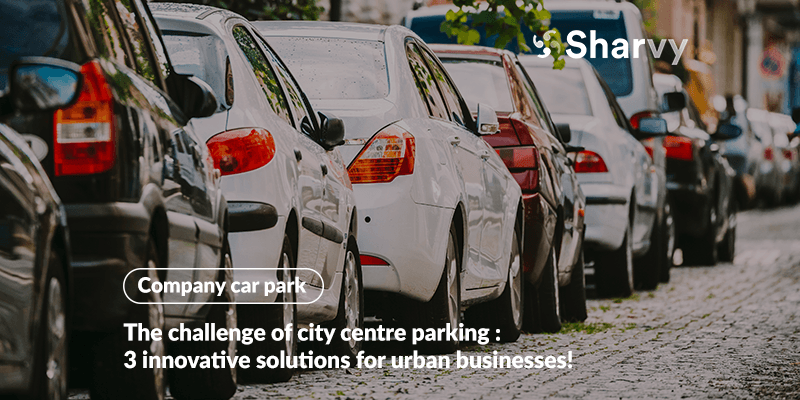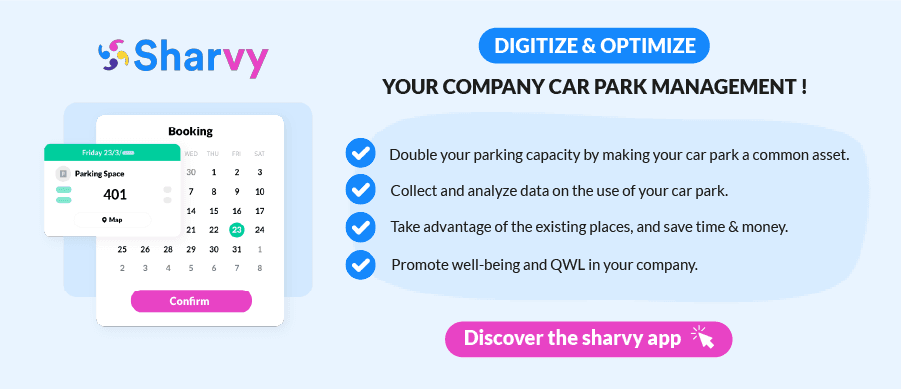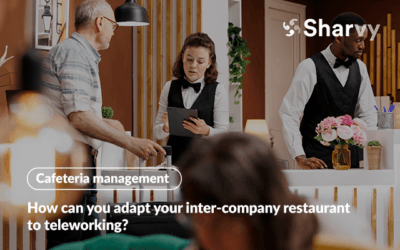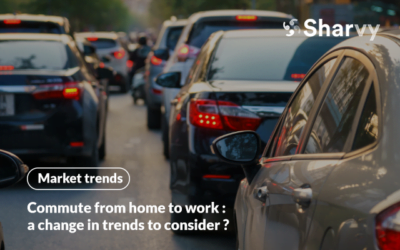Do you have a company car park right in the centre of town? Let’s be honest : it’s become a privilege. But even with a few reserved spaces, let’s be clear : it’s no longer enough.
A handful of spaces in the basement of a building won’t stop the daily tide of employees, customers, and delivery drivers all desperately searching for a place to park.
The result? Repeated delays, widespread frustration, and logistics that quickly fall apart under pressure. Even the most organised teams end up suffering.
So, what can you do when you can’t push back the walls or create parking spaces out of thin air? In this article, we suggest three practical and clever solutions to breathe new life into your company car park.
City centre parking : a resource under pressure in 2025.
1. Growing pressure on urban space.
Let’s face it : in recent years, city centre parking has become a real headache.
Spaces are increasingly scarce, prices are skyrocketing and, every month, new spaces are taken away to create cycle paths, pedestrian zones & lanes reserved for public transport.
Mind you, this is not necessarily a bad thing. These changes make our city centres more pleasant, more breathable and more human. But they don’t make life any easier for businesses!
Take Paris, for example : 70,000 parking spaces have been eliminated in just ten years. Some streets have become 100% pedestrianised, while others are reserved for public transport and soft mobility.
For your company, these changes have direct and sometimes tricky consequences.
You have employees to bring in, customers to welcome and deliveries to manage. But with limited parking spaces, rising costs and increasingly complex journeys, accessibility in the heart of cities is becoming a real strategic challenge.
2. The consequences for urban businesses.
It’s not just a temporary inconvenience. The lack of parking in the city centre is a real killer for urban businesses.
Every minute spent driving around the area looking for a parking space means lost productivity. Employees who arrive stressed and tired before they’ve even started their day. Customers who throw in the towel for lack of convenient parking. And delivery drivers who are delayed, or worse, fined.
The result : skyrocketing costs. Logistical costs, of course – but also human costs. A company that’s less accessible is a company that’s less attractive. Fewer talents, fewer partners, fewer customers. It’s a real loss of attractiveness, sometimes invisible… until the day it hurts.
And then there’s image. In today’s fast-paced world, a company that is perceived as « and difficult to access » quickly becomes a company to be avoided. Even with the best services in the world, the employee experience starts as soon as you enter the car park.
So no, parking at a company (and in the city centre at that) is not just a « minor inconvenience ». It’s an obstacle to your growth, to your attractiveness, and sometimes to your day-to-day operations. Fortunately, there are solutions. Find out more below.
3 innovative solutions to the city centre parking challenge!
1. Sharing parking spaces : a new era of flexibility.
What if the solution to city centre parking lay in collective intelligence? Quite simply, by sharing parking spaces between employees.
Here’s the idea : instead of leaving parking spaces unused when an employee is teleworking, travelling or absent (sick, day-off), why not make them available to others?
Thanks to dedicated applications such as Sharvy, it is now possible for an employee who owns a parking space to indicate his or her space as « free » on the application. Other users, whether employees or third parties (delivery drivers, visitors, partners), can then reserve and use this parking space during the period when it is unused.
In this way, the employee retains their allocated space, but shares it flexibly during their absence, optimising the occupancy rate of your company car park.
However, if you want it to work, it’ s crucial that all users play along. On the one hand, this means that the employee who has a parking space must remember to vacate it if he or she is absent.
On the other hand, those who reserve these spaces must ensure that they respect their commitment. This implies that they actually use the reserved space, and in the event of unforeseen circumstances, that they cancel their reservation in time to allow another user to take advantage of it.
No-shows (reservations that are not honoured) upset the balance of the system by preventing other employees & visitors from accessing seats that could be free.
In short, this system is based on shared responsibility : each user must be aware of the impact of his or her actions and must contribute to fair and efficient parking management.
2. Remote parking, thanks to shuttles and soft mobility.
As you will have realised, city centre car parks are becoming increasingly rare and expensive. So why not take a step backwards, and move forward? After all, what if the solution was to get out of the heart of the city to get to it more easily?
Imagine car parks on the outskirts where you can park your car (free of charge) and, rather than struggling to find a space in the crowded streets, take a company shuttle bus, or use electric scooters & shared bikes to cover the last few kilometres. It‘ s a practical, economical and, above all, sustainable solution.
Free shuttles and soft mobility become a bridge between the suburbs and the city centre, facilitating access to work and relieving congestion in city centres.
What’s more, by encouraging your employees not to drive to the site, you reduce the pressure on your own parking capacity. The result: less space to build, rent and maintain in town centres (where m² is very expensive).
And if you’re wondering how to effectively manage shuttle slots to avoid overcrowding, don’t worry: tools like Sharvy are there for you.
Your employees can book their place on a shuttle directly from the application, just as they would book a parking space. With just a few clicks, they can choose a time slot, a departure point and, if they wish, a return. Everything is visible in real time.
Sharvy automatically avoids overcrowding and ensures a smooth flow of traffic. If a member of staff can’t make it in the end, they can cancel their booking at the click of a button, freeing up a place for someone else. It’s simple, responsive and, above all, highly effective in maximising the occupancy rate!
So by relying on well-organised shuttles, you’re not just improving your employees’ mobility : you’re also helping to relieve congestion in city centres.
3. Company car-sharing, with priority access to company car parks.
Every morning, dozens of cars arrive at your site, but very often with only one person on board. The result : a saturated car park, struggling employees and a growing carbon footprint.
What if you could reverse the trend? With company car-sharing, you can encourage your teams to share their journey, while rewarding them with priority access to the company car park and a guaranteed seat on arrival on site.
How can you do this? Either by designating spaces in your car park exclusively for carpooling (a handful of 3 to 5 spaces, depending on your parking capacity), thus creating a dedicated space for those who choose to come together.
Alternatively, you can use an application such as Sharvy, where your employees register their carpooling journeys from Karos and, in return, receive priority reserved parking spaces in your car park via Sharvy. These spaces are generally strategically located (often near the building entrances).
By promoting this practice, you optimise the use of your parking spaces and create a culture of solidarity and responsibility. A winning solution for both your employees and your company.
Ready to take action? 5 tips for deploying these solutions in your company!
Talking about innovation is all very well. But in practical terms, how do you get things moving in your company? Here’s some advice on how to turn your intentions into concrete, effective action:
- Analyse what already exists. Before you act, take stock. How many places are available? What is the average occupancy rate in your company car park? Who uses the car park, and when? A simple diagnosis can reveal unsuspected levers.
- Get your teams on board. A solution only works if it’s shared. By involving your staff from the outset, you can turn change into a collective project. A survey and workshops can be all it takes to generate good ideas.
- Rely on technology. There’s no need to invent the wheel. Tools like Sharvy allow you to easily manage reservations, seat sharing, shuttle slots and carpooling priorities.
- Evaluate, adjust, improve. Monitor usage, listen to feedback and adjust the rules if necessary. A good parking system evolves with the company and the habits of your employees.
In conclusion
For many companies, parking in town centres has become a daily headache. Fewer spaces, more constraints, and constant pressure to satisfy the needs of employees and customers alike, as well as environmental requirements.
Yet behind this challenge lies a real opportunity.
It’s not a question of having more space, but of using it better.
By adopting one or more of the solutions discussed in this article, you can turn your parking policy into a performance lever. It’s not a question of square metres, but of common sense and organisation.
The idea is to move from a logic of possession to a logic of use. And with the right tools, this transition becomes fluid, measurable and beneficial for everyone!
Do you have a question? Check out the following FAQ !
How long does it usually take to implement these solutions?
Implementing these solutions may be quicker than you think.
For example, the management of shared parking spaces using a dedicated application, such as Sharvy, can be implemented in just a few weeks. On average, it takes 3 to 4 weeks from the time our support team receives all the information needed to create a Sharvy space.
Obviously, the time taken to deploy the solution varies according to the profile of the space to be created (whether or not there are technical specifications, installation of access control equipment, specific developments, etc.).
Alternatively, the application can be synchronised with your internal management system (HRIS), and all you need to do is train your staff to use it. If you wish, we can also train your staff by videoconference.
What if your employees don’t adapt to these new solutions?
This is a legitimate concern. Any transition (even for a good cause) upsets habits, and parking in the city centre is no exception to the rule.
Some employees are likely to be sceptical or reticent when faced with new practices. But don’t panic: adoption can (and should) be a gradual process.
Start by clearly informing them of the issues at stake: lack of parking spaces, cost of parking, ecological impact. Then encourage them to try it out by rewarding the first users: reserved spaces, tangible benefits, internal recognition, etc.
To take things further, add a touch of fun with a little gamification: rankings, small collective challenges, etc. Finally, be flexible. Mistakes are part of the process.
By creating a benevolent and motivating climate, parking within your company will gradually become a fluid, collective experience… and much more enjoyable.
Want to find out more? Check out our latest articles to stay up to date!
How can your inter-company restaurant adapt to teleworking?
Teleworking : how can you manage the number of people using your inter-company restaurant & adapt your offer to new working habits? Focus.
Change management : how to facilitate the adoption of a new tool?
What are the essential steps to facilitate change management in your company ? Our advice and best practices can be found here.
Commute from home to work : a change in trends to consider ?
Commute from home to work : what trends can be observed? What are the risks? How can they be improved? Focus in this article.
Subscribe to our newsletter!
PARKING & WORKPLACE MANAGEMENT SOLUTION
Car park management - Charging points monitoring - Desk booking - Booking by time slots
SUBSCRIBE TO THE NEWSLETTER
Receive the latest Parking & Workplace trends by email once a month.












